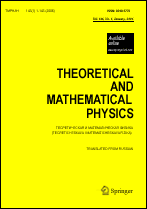|
This article is cited in 8 scientific papers (total in 8 papers)
A Simple Cluster Model for the Liquid–Glass Transition
V. N. Ryzhova, E. E. Tareevaa, T. I. Shchelkachevaa, N. M. Shchelkachevab
a Institute for High Pressure Physics, Russian Academy of Sciences
b L. D. Landau Institute for Theoretical Physics, Russian Academy of Sciences
Abstract:
Using the classical distribution-function approach to simple liquids, we estimate the orientational interaction between clusters consisting of a particle and its nearest neighbors. We show that there are density and temperature ranges where the interaction changes sign as a function of the cluster radius. On this basis, the corresponding model of interacting cubic and icosahedral clusters (of the type of a spin glass model) is proposed and solved in the replica-symmetric approximation. We show that the glass order parameter grows continuously on cooling and the replica-symmetry-breaking temperature can be identified with the glass transition temperature. We also show that on cooling a system of particles with a Lennard–Jones interaction, cubic clusters freeze first. The transition temperature for icosahedral clusters is somewhat lower; therefore, the cubic structure of the short-range order is more likely in a Lennard–Jones glass near transition.
Keywords:
short-range order, local structure of liquid, orientational glass.
Received: 12.01.2004
Revised: 30.01.2004
Citation:
V. N. Ryzhov, E. E. Tareeva, T. I. Shchelkacheva, N. M. Shchelkachev, “A Simple Cluster Model for the Liquid–Glass Transition”, TMF, 141:1 (2004), 131–140; Theoret. and Math. Phys., 141:1 (2004), 1443–1451
Linking options:
https://www.mathnet.ru/eng/tmf117https://doi.org/10.4213/tmf117 https://www.mathnet.ru/eng/tmf/v141/i1/p131
|


| Statistics & downloads: |
| Abstract page: | 601 | | Full-text PDF : | 221 | | References: | 94 | | First page: | 2 |
|




 Contact us:
Contact us: Terms of Use
Terms of Use
 Registration to the website
Registration to the website Logotypes
Logotypes








 Citation in format
Citation in format 
